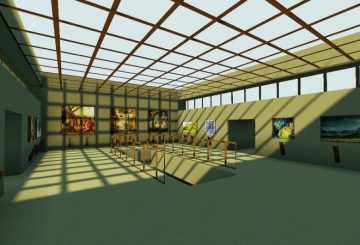The Sydney Festival isn’t much of a visual arts event. Consisting of little more than a handful of exhibitions at galleries that would have held them anyway, without an overall curator or a single catalogue, the visual arts program is a grab bag of events sheltering under a logo and a PR budget.
While the Festival has had its successes in the past, its hit and miss organisation can be disastrous. Nam June Paik, the Korean-born American artist, was the 2004 Festival’s international inclusion and his two works Transmission and 32 Cars for the 20th Century Play Mozart’s Requiem Quietly were installed at the Opera House forecourt.
Paik is often and aptly described as a seminal figure. A one time member of the Fluxus movement of the early 1960s (along with such luminaries as Josef Beuys and Yoko Ono), Paik’s early work with video was highly influential and as a musician and composer, his pieces with the cellist Charlotte Moorman saw him expanding the very limits of musical performance. Collector and arts philanthropist John Kaldor brought Paik and Moorman to Sydney in 1976 where, among other things, the cellist was tied to balloons and flown over the Opera House and at another performance played a cello made from three TV monitors (designed by Paik) screening images of Moorman in the nude.
But as with many seminal figures, Paik’s work has been remembered more for its historical importance than for its lasting artistic or aesthetic merits. The Fluxus artists were anti-art Neo Dadaists who were more concerned with the democratising of process than end results, so performance pieces, happenings and music were the norm rather than lasting art objects such as paintings and sculptures that could be bought and sold and put in museums. The Fluxus artists and Paik in particular, were also Zen humourists not averse to a joke at the expense of themselves and the audience. Paik’s best work wasn’t for the ages, it was for the here and now (or ‘there and then’ as it is today).
At the age of 72, Paik is alive and well and working but instead of performances and anti-art gestures he’s been making large scale commissions for public spaces. Anti-art doesn’t really pay the bills and Paik’s installations, in collaboration with artist Norman Ballard, have become grander and grander – an installation he did for the Seoul Olympics utilised over 1000 video monitors. (It’s a long way from one of his bet known works, TV Buddha – that was a store-bought statue of the lion of dharma watching a live feed of his own image on a TV screen.)
Which brings us to Transmission and 32 Cars. Initially designed for New York’s Rockefeller Center and installed there in 2003, these two pieces would have made a certain kind of sense. The RKO tower referenced in Transmission once stood in the Rockefeller Plaza and the 32 Cars alluded to the fact that the Rockefeller fortune came from oil. Putting the rather ghastly aesthetics of the two works aside – crappy metals and old cars spray painted silver – the pieces were made for that space and although oblique, their references were apt.
In Sydney, however, the installation of the pieces was a shambles. We were presented with a “selection from” 32 Cars; that is, we only had 16 old Fords and Packards arranged around the tower, which itself was plonked down with little reference or regard for its location. The laser beams that shot out of the tower were kind of fun in an ooh-ahh fireworks way, but the images they traced out on the Botanical Gardens rock wall were an embarrassment of overwrought symbolism – a pictographic history from “primitive” animals and men up to a space age light show courtesy of some non linear equations. The two works – mistaken by many for a single piece – were jammed into the space between the stairs of the Opera House and the Botanical Gardens with a seemingly haphazard arrangement of cars and central tower.
Meanwhile, another Sydney Festival event just across the water called City of Light transformed the Sydney Harbour Bridge into a light show that was like a cross between a Nuremberg rally and Close Encounters of The Third Kind. Going off at the same time, Paik’s little tower and laser light show looked very modest indeed.
Paik’s older, better work was about repetition – both the implied kind and the actual kind – the forms suggesting a Zen-like infinitude in the recursive depths of pop culture, held in place by the framing device of the TV screen. That his work has had little time for traditional art aesthetics were both its charm and its liability – he might be historically important but you’d be mad to describe either of these latest works as beautiful. Anti-art will only take you so far and to ignore an installation piece’s new surroundings is to invite just the kind of calamity that occurred at the Sydney Festival.
There were tiny slivers of the older themes of Paik’s work in the show, but the installation was so poor and the presentation so inept, they were only faint echoes of an artist long past his prime. Without any real money from the Sydney Festival to mount a proper Paik retrospective or enough cash to create a new site specific work, the Festival’s inclusion of Transmission and 32 Cars didn’t do anyone any good. Now you can see it, if you dare, at the National Gallery of Australia, where it has as much to do with the Rockefeller Center as it did in Sydney.

